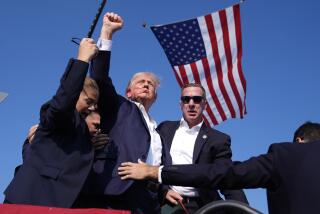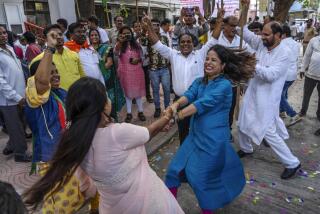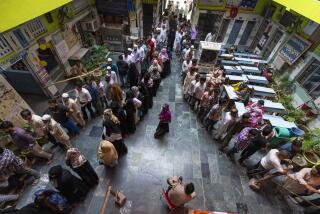Hi-Tech, Antiquity Coexist as India’s Politicians Return to Campaign Trail : Election: Parties resume the quest for votes, 10 days after the assassination of Gandhi.
- Share via
NEW DELHI — In an ultramodern control room in the south suburbs of New Delhi on Saturday, the video wizards of Jain Studios unveiled their latest creation: a post-assassination campaign video for the powerful Hindu revivalist Bharatiya Janata Party. It includes a color-photo re-creation of Rajiv Gandhi’s assassination and the assertion that Gandhi’s Congress-I Party was the sole cause of the politics of violence that destroyed its own leader.
Copies of the video were sent Saturday to villages and towns throughout India.
While that was happening, the leadership of Gandhi’s party gathered for a mass “condolence” meeting on the capital’s Ram Lila Grounds, a sacred spot where religious leaders annually re-enact the fiery death of an evil demigod from the land now known as Sri Lanka--the presumed homeland of the suicide-assassin who killed Gandhi with a bomb at a May 21 rally.
And, in the southern metropolis of Hyderabad, Indian film-star-turned-politician N. T. Rama Rao, who has portrayed the Hindu god Krishna so often that many believe he is a living incarnation, sat cross-legged near a holy lake where he launched a hunger strike and public vow of silence on behalf of the country’s third political force, the National Front of former Prime Minister Vishwanath Pratap Singh. Rama Rao began issuing blistering attacks on Gandhi’s party and the BJP by writing them on a note pad at his side.
With this kaleidoscopic clash of time and faith, a nation in which antiquity coexists with high tech began limping its way back to the campaign trail.
Ten days after Gandhi’s assassination shocked the nation at the peak of parliamentary elections, candidates and party leaders formally re-emerged from long strategy sessions and fanned out through the country in search of votes for the 313 seats at stake when India’s staggered balloting resumes later this month.
The voting will determine which of the three major political forces rules in the 545-seat Indian Parliament--a choice that ranges from the BJP’s promise of India’s first right-wing Hindu government to the traditional socialism of Gandhi’s Congress-I and the party mavericks who split from it to form the National Front.
The election began May 20, when more than 200 seats were decided but not tallied or announced. Voting was suspended within hours of the attack that killed Gandhi while he was receiving garlands at an election rally in southern India, and the remaining seats that represent nearly two-thirds of Parliament will be determined June 12 and 15.
Analysts said it is still too early to assess the impact Gandhi’s death will have on the election outcome and the nation’s future. But as campaign imagery reappeared on the political landscape Saturday, it was clear that Gandhi’s death has radically altered the shape and color of the political forces vying to win over India’s hundreds of millions of largely illiterate voters.
The leadership of Gandhi’s Congress-I, India’s oldest and longest-ruling political party, made it clear that their star campaigner remains unchanged. It will be the party’s latest martyr.
In the last campaign of his life, Gandhi took the Congress-I promise of a stable and unified India on a barnstorming tour of all 22 Indian states. Now, the party will use cardboard cutouts of Gandhi and his slain mother, Indira Gandhi, towering larger than life over the countryside beneath the slogan, “Vote for the sacrifices of India’s greatest martyrs.”
And Congress-I technicians are at work on a campaign video of their own, which will feature Gandhi’s funeral and his widow’s 21-hour, whistle-stop train tour that carried the fallen leader’s ashes from the capital to their final destination.
With no one named Gandhi to lead its campaign--the slain leader’s widow, Sonia, repeatedly rejected the party’s efforts to draft her--Congress-I will use such props to try to capture a wave of sympathy and overcome growing disarray within its ranks and the fact that it has no clear leader to offer the country as prime minister if it wins the elections.
Former Prime Minister Singh and India’s current caretaker Prime Minister Chandra Shekhar, both former members of Gandhi’s party who now lead the National Front, took swipes at Congress-I during their campaign rallies this weekend. But their prime target was the Hindu revivalists of the Bharatiya Janata Party.
More than any other party, BJP has most radically altered its campaign in the wake of Gandhi’s death, a sophisticated and graphic shift that has stunned even the most critical analysts with its swiftness and ingenuity.
Like the video created by BJP activist and high-tech entrepreneur J. K. Jain, the new strategy was in the works even before Gandhi’s remains were cremated three days after he was slain.
“Time is exceedingly short,” Jain declared in a strategy paper adopted during a party executive committee meeting that took place as Gandhi’s ashes were being collected from his pyre. “We need a strategy to counteract the politics and propaganda of an unscrupulous and exploitative Congress-I leadership.”
As a result, Jain not only made a powerful videotape as the campaign’s centerpiece, but he allocated 120 so-called video chariots--custom-built trucks with rear projectors, screens and generators--to stage 900 “electronic public meetings” for the BJP in the most remote corners of India.
The content of the revivalists’ post-assassination campaign, however, was best enunciated by Arun Jaitley, 38, an appellate court lawyer and one of the most powerful creative forces in the party.
Jaitley said in an interview Friday night that the Congress-I had little choice after Gandhi’s assassination. “It was a no-win situation.
“If it (the party leader) was Sonia Gandhi, the sympathy factor may have been higher, but the revulsion of the nation at the prospect of an Italian, Catholic prime minister would have undercut it. In fact, Ram would have become more relevant,” Jaitley said, referring to the Bharatiya Janata Party’s campaign promise to build a birthplace temple to Lord Rama on the site of an ancient Islamic mosque.
“And if it’s not Sonia, it’s a leaderless party . . . a party that will always face a potential--or imminent--breakup.
“The question was how the BJP could best adapt to this scenario . . . “
At that point, Jaitley reached into a pile of papers on his desk and pulled out the proofs of a new campaign poster that will appear by the millions in the 313 districts where voters will go to the polls in the next two weeks.
The poster bears a photograph of all four nationally recognized BJP leaders, including that of party chairman L. K. Advani, projected as the most likely prime minister if the party comes to power. Above the photograph, are the words: “Parties without leaders! Leaders without parties! Parties on the verge of disintegration! Enough is Enough!”
In smaller print at the bottom, the poster says: “India needs a strong party and mature leadership, a party that can guarantee the nation’s stability, unity, integrity and identity. India needs the BJP. Let’s go for am Rajhya”-- the rule of Lord Rama.
More to Read
Sign up for Essential California
The most important California stories and recommendations in your inbox every morning.
You may occasionally receive promotional content from the Los Angeles Times.













